语言学大作业
国开2023春《语言学概论》形考任务1-3+大作业参考答案

国开2023春《语言学概论》形考任务1-3+终考任务参考答案形考任务一考查知识:绪论、第一章、第二章;权重:15%一、判断正误(每题5分,共50分)1.语言学的研究对象是人类的自然语言。
判断题(5分)5分 A.对 B.错2.语言是人类最重要的交际工具。
判断题(5分)5分 A.对 B.错3.语言的本质属性是社会性。
判断题(5分)5分 A.对 B.错4.音节是最小的语音单位。
判断题(5分)5分 A.对 B.错5.元音和辅音最本质的区别是声带振动与否。
判断题(5分)5分 A.对 B.错6.洪堡特是布拉格学派的代表人物。
判断题(5分)5分 A.对 B.错7.语言是一种自然现象,也是一种生理现象。
判断题(5分)5分 A.对 B.错8.语言单位在语流中产生的相互关系就是组合关系。
判断题(5分)5分 A.对 B.错9.肺是人类发音器官中最主要的动力提供源。
判断题(5分)5分 A.对 B.错10.按照共鸣器的形状不同,元音可分为舌面元音和舌尖元音。
判断题(5分)5分 A.对 B.错二、单项选择(每题5分,共50分)11.()被称为现代语言学之父。
单选题 (5 分) 5 分A.韩礼德B.布龙菲尔德C.索绪尔D.乔姆斯基12.以下关于语言和言语区别的说法,不正确的是()。
单选题(5分)5分A.社会性和个人性B.有限性和无限性C.长期性和短期性D.稳定性和变易性13.语言变体的类型中不包括()。
单选题(5分)5分A.社会变体B.地域变体C.风格变体D.自然变体14.音位是从()角度划分出来的最小语言单位。
单选题 (5 分) 5 分A.物理属性B.生理属性C.心理属性D.社会属性15.国际音标是以()为基础构成的,通常把它放在方括号中,与一半字母相区别。
单选题(5分)5分A.拉丁字母B.罗马字母C.拼音字母D.英文字母16.语言符号与其他符号的区别不包括( )。
单选题(5分)5分A.线条性B.单一性C.层级性D.历史传承性17.关于功能语言学派,下列说法不正确的是( )。
西南大学课程考试 [0181] 语言学导论 大作业(资料)
![西南大学课程考试 [0181] 语言学导论 大作业(资料)](https://img.taocdn.com/s3/m/c1a213c259eef8c75ebfb39a.png)
西南大学培训与继续教育学院课程考试试题卷学期:2020年秋季课程名称【编号】:语言学导论【0181】 A卷:大作业:100分________________________________________,Ⅰ. For each question there are four choices. Decide which one would be the best answer to the question, or would best complete the sentence. Write the corresponding letter on your ANSWER SHEET. (20%)1. _______are bound morphemes because they cannot be used as separate words.A. RootsB. StemsC. AffixesD. Compounds2. The relation between the two words “buy” and “sell” can be described as____.A. gradable antonymyB. converse antonymyC. complementary antonymyD. synonymy3. The last phoneme in the word “hang” is a_______.A. glottalB. palatalC. dentalD. nasal4. Three places of articulation that involve the teeth and/or the lips are_____.A. palatal, velar, glottalB. bilabial, labiodental, interdentalC. stop, fricative, affricativeD. nasal, lateral, semi vowel5. The four major modes of semantic change are_______.A. extension, narrowing, elevation and degradationB. extension, generalization, elevation and degradationC. extension, narrowing, specialization and degradationD. extension, elevation, amelioration and degradation6. Language serves the _______ function when it is used to talk about language itself.A. recreationalB. metalingualC. phaticD. performative7. Identify the morphemes in the word “unimaginative”________.A. un-im-ag-in-at-iveB. un-imaginativeC. un-imagin-ativeD. unimagin-ative8. The Cooperative Principle that language users are believed to follow was initially proposed by_________.A. GriceB. AustinC. ChomskyD. Saussure9. The Whorf Hypothesis claims that_______.A. language is full of “rich points”, whose meanings are difficult to translate into another languageB. abstract terms are easily translatable .C. accents are part of identityD. language influences culture-specific ways of knowing10. The syllabic structure of the word “achieved” is ______.A. VCCVCCB. VCVCCC. VCVVCVCD. VCCVCVC5Ⅱ. Decide whether each of the following statements is True or False.11. Cultural transmission refers to the study of the language development or change over time.12. Compounds are words formed by combining parts of other words.13. Arbitrariness refers to the fact that there is no logical connection between the signifier and the signified of a sign.14. Pragmatics is the study of meaning in context or the study of language in use.15. Blending is a way by which a word is produced by stringing together words.16. Ultimate constituents are the smallest grammatical units obtained through binary segmentation17. Diachronic linguistics studies the details of the linguistic system must be learned anew by each speaker.18. Displacement refers to the fact that language can used to talk about things that are absent in time or space.19. Creole is a language formed when a pidgin has become the primary language of a speech community.20. Antonymy refers to the sameness of meaning between words.Ⅲ. Reading comprehension. Read the following passage and answer each of the questions based on it. Choose the correct answer write the corresponding letter on the ANSWER SHEET. (20%)Language learning begins with listening. Individual children vary greatly in the amount of listening they do before they start speaking, and late starters are often long listeners. Most children will “obey” spoken instructions some time before they can speak, though the word “obey” is hardly accurate as a description of the eager and delighted cooperation usually shown by the children. Before they can speak, many children will also ask questions by gesture and by making questioning noises. Any attempt to trace the development from the noises babies make to the first spoken words leads to considerable difficulties. It is agreed that they enjoy making noises, and that during the first few months one or two noises sort themselves out as particularly indicative of delight, distress, sociability, and so on. But since these cannot be said to show the baby’s intention to communicate, they can hardly be regarded as early forms of language. It is agreed, too, that from about three months they play with sounds for enjoyment, and that by six months they are able to add new sounds to their store. This self-imitation leads on to deliberate imitation of sounds made or words spoken to them by other people. The problem then arises as to the point at which one can say that these imitations can be considered as speech. It is a problem we need not get out teeth into. The meaning of a word depends on what a particular person means by it in a particular situation; and it is clear that a child means by a word will change as the gains more experience of the world. Thus the use, at say even months, of “mama” as a greeting for his mother can not be dismissed as a meaningless sound simply because he also uses it at other times for his father, his dog, or anything else he likes.Playful and apparently meaningless imitation of what other people say continues after the child has begun to speak for himself. I doubt, however, whether anything is gained when parents cash in on this ability in an attempt to teach new sounds.21. Before children start speaking, they ______.A. need equal amount of listeningB. need different amounts of listening,C. are all eager to cooperate with the adults by obeying spoken instructionsD. can’t understand and obey the adult’s oral instructions22. Children who start speaking late _______.A. may have problems with their hearingB. probably do not hear enough language spoken around themC. usually pay close attention to what they hearD. often take a long time in learning to listen properly23. A baby’s first noise is a(n) ______.A. reflection of this moods and feelingsB. early form of language'C. sign that he means to tell you somethingD. imitation of the speech of adults24. The problem of deciding at what point a baby’s imitations can be considered as speech is _______A. important because words have different meanings for different people8B. not especially important because the change-over takes place graduallyC. one that can never be properly understood because the meaning of words changes with ageD. one that should be completely ignored because children’s use of words is often meaningless25. It is implied in the passage that ______.A. parents can never hope to teach their children new soundsB. children no longer imitate people after they begin to speakC. children who are good at imitating learn new sounds more quickly.D. even after they have learnt to speak children still enjoy imitatingⅣ. Answer the following questions, each in 120 to 200 words. Write your answer on the ANSWER SHEET. (40%)26. How is linguistics different from traditional grammar? (20%)27. What have you learned from the course of linguistics? (20%)(Clue: You can say whatever, linguistic or non-linguistic, you have learned from the course. But make sure your answer is clear and logical. You may answer the question in Chinese, but this may result in a loss of marks.)。
大学《语言学导论》试题及答案
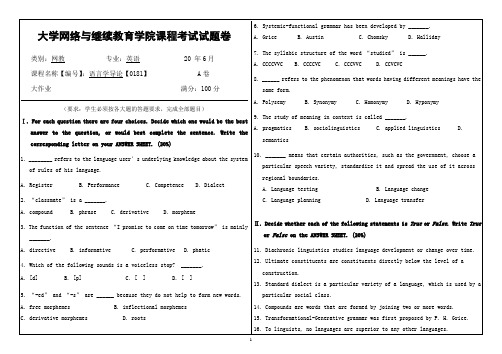
大学网络与继续教育学院课程考试试题卷类别:网教专业:英语 20 年6月课程名称【编号】:语言学导论【0181】 A卷大作业满分:100分(要求:学生必须按各大题的答题要求,完成全部题目)Ⅰ. For each question there are four choices. Decide which one would be the best answer to the question, or would best complete the sentence. Write the corresponding letter on your ANSWER SHEET. (20%)1. ________ refers to the language user’s underlying knowledge about the systemof rules of his language.A. RegisterB. PerformanceC. CompetenceD. Dialect2. “classmate” is a _______.A. compoundB. phraseC. derivativeD. morpheme3. The function of the sentence “I promise to come on time tomorrow” is mainly_______.A. directiveB. informativeC. performativeD. phatic4. Which of the following sounds is a voiceless stop? _______.A. [d]B. [p]C. []D. []5. “-ed” and “-s” are ______ because they do not help to form new words.A. free morphemesB. inflectional morphemesC. derivative morphemesD. roots 6. Systemic-functional grammar has been developed by _______.A. GriceB. AustinC. ChomskyD. Halliday7. The syllabic structure of the word “studied” is ______.A. CCCCVVCB. CCCCVCC. CCCVVCD. CCVCVC8. ______ refers to the phenomenon that words having different meanings have thesame form.A. PolysemyB. SynonymyC. HomonymyD. Hyponymy9. The study of meaning in context is called _______.A. pragmaticsB. sociolinguisticsC. applied linguisticsD.semantics10. _______ means that certain authorities, such as the government, choose aparticular speech variety, standardize it and spread the use of it across regional boundaries.A. Language testingB. Language changeC. Language planningD. Language transferⅡ. Decide whether each of the following statements is True or False. Write True or False on the ANSWER SHEET. (20%)11. Diachronic linguistics studies language development or change over time.12. Ultimate constituents are constituents directly below the level of aconstruction.13. Standard dialect is a particular variety of a language, which is used by aparticular social class.14. Compounds are words that are formed by joining two or more words.15. Transformational-Generative grammar was first proposed by P. H. Grice.16. To linguists, no languages are superior to any other languages.- 1 -- 2 -- 3 -。
《语言学概论》作业
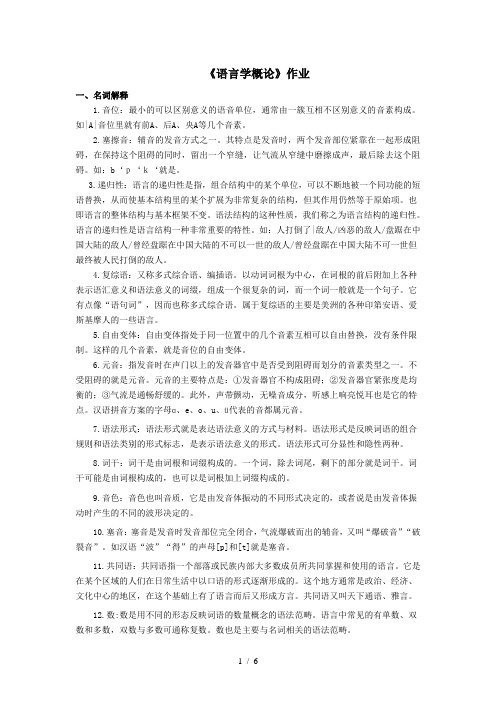
《语言学概论》作业一、名词解释1.音位:最小的可以区别意义的语音单位,通常由一簇互相不区别意义的音素构成。
如|A|音位里就有前A、后A、央A等几个音素。
2.塞擦音:辅音的发音方式之一。
其特点是发音时,两个发音部位紧靠在一起形成阻碍,在保持这个阻碍的同时,留出一个窄缝,让气流从窄缝中磨擦成声,最后除去这个阻碍。
如:b‘p‘k‘就是。
3.递归性:语言的递归性是指,组合结构中的某个单位,可以不断地被一个同功能的短语替换,从而使基本结构里的某个扩展为非常复杂的结构,但其作用仍然等于原始项。
也即语言的整体结构与基本框架不变。
语法结构的这种性质,我们称之为语言结构的递归性。
语言的递归性是语言结构一种非常重要的特性。
如:人打倒了|敌人/凶恶的敌人/盘踞在中国大陆的敌人/曾经盘踞在中国大陆的不可以一世的敌人/曾经盘踞在中国大陆不可一世但最终被人民打倒的敌人。
4.复综语:又称多式综合语、编插语。
以动词词根为中心,在词根的前后附加上各种表示语汇意义和语法意义的词缀,组成一个很复杂的词,而一个词一般就是一个句子。
它有点像“语句词”,因而也称多式综合语。
属于复综语的主要是美洲的各种印第安语、爱斯基摩人的一些语言。
5.自由变体:自由变体指处于同一位置中的几个音素互相可以自由替换,没有条件限制。
这样的几个音素,就是音位的自由变体。
6.元音:指发音时在声门以上的发音器官中是否受到阻碍而划分的音素类型之一。
不受阻碍的就是元音。
元音的主要特点是:①发音器官不构成阻碍;②发音器官紧张度是均衡的;③气流是通畅舒缓的。
此外,声带颤动,无噪音成分,听感上响亮悦耳也是它的特点。
汉语拼音方案的字母ɑ、e、o、u、ü代表的音都属元音。
7.语法形式:语法形式就是表达语法意义的方式与材料。
语法形式是反映词语的组合规则和语法类别的形式标志,是表示语法意义的形式。
语法形式可分显性和隐性两种。
8.词干:词干是由词根和词缀构成的。
一个词,除去词尾,剩下的部分就是词干。
《语言学概论》网上作业题答案

(0126)《语言学概论》网上作业题答案1:第一批次2:第二批次3:第三批次4:第四批次5:第五批次6:第六批次1:[单选题]1、汉语中"北平→北京”、"德律风→电话”,产生词语替换的原因是()A:社会的因素B:语言系统内部的因素C:前者是语言系统内部因素,后者是社会因素D:前者是社会因素,后者是语言系统内部因素参考答案:D郭沫若、郁达夫、成仿吾、田汉、郑伯奇2:[单选题]2、《庄子》里"匠石运斤成风”中的"匠石”,现代汉语说"名叫做石的工匠”。
这个差别所反映的汉语语法发展事实属于()A:组合规则的发展B:聚合规则的发展C:结构关系的变化D:语法范畴的变化参考答案:A郭沫若、郁达夫、成仿吾、田汉、郑伯奇3:[单选题]3、"拖拉机”一词是()A:意译词B:仿译词C:借词D:方言词参考答案:A郭沫若、郁达夫、成仿吾、田汉、郑伯奇4:[单选题]4、"洋泾浜”()A:可以作为母语为学习B:没有人把它作为母语来学习C:可以作为第一语言进行交际D:不可以用作书面语形式参考答案:B5:[单选题]5、重庆话和上海话的差异,主要体现在()A:语音B:词汇C:语法D:语义参考答案:A郭沫若、郁达夫、成仿吾、田汉、郑伯奇6:[多选题]6、现代汉语中"老师”和"老人”中的"老”是()A:都是语素B:都不是语素C:是同一个语素D:是不同的语素E:前者不是语素,后者是语素参考答案:AD郭沫若、郁达夫、成仿吾、田汉、郑伯奇7:[多选题]7、"鸡”、"几”两个字的日译汉音分别是kei和ki。
从中可以看出()A:两个字原先同音B:两个字原先不同音C:两个字原来的声母跟普通话相同D:两个字原来的声母跟普通话不同E:古代借词对研究语音发展有价值参考答案:DE郭沫若、郁达夫、成仿吾、田汉、郑伯奇8:[多选题]8、世界上独立形成的古老的文字体系有()A:用拉丁字母作为文字符号的文字B:中美洲的马雅文C:用阿拉伯字母作为文字符号的文字D:古埃及的圣书字E:汉字参考答案:BDE郭沫若、郁达夫、成仿吾、田汉、郑伯奇9:[判断题]9、听觉语音学是从生理属性方面去研究语音的参考答案:错误10:[判断题]10、渐变性和不平衡性是语言发展的两大特点参考答案:正确人的本质并不是单个人所固有的抽象物。
语言学概论练习题
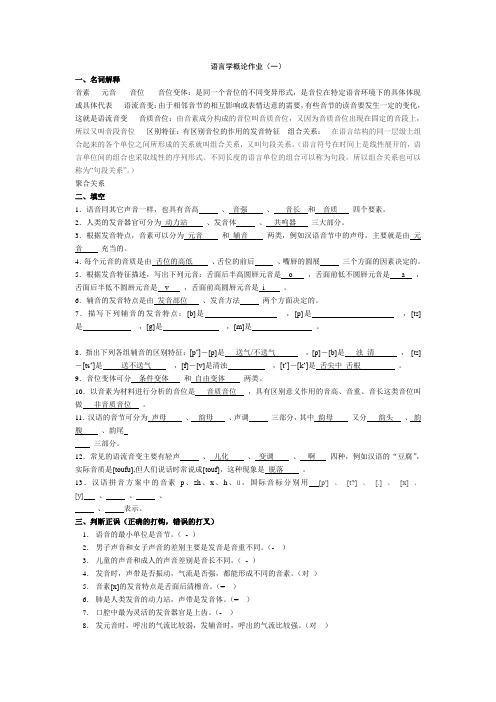
语言学概论作业(一)一、名词解释音素元音音位音位变体:是同一个音位的不同变异形式,是音位在特定语音环境下的具体体现或具体代表语流音变:由于相邻音节的相互影响或表情达意的需要,有些音节的读音要发生一定的变化,这就是语流音变音质音位:由音素成分构成的音位叫音质音位,又因为音质音位出现在固定的音段上,所以又叫音段音位区别特征:有区别音位的作用的发音特征组合关系:在语言结构的同一层级上组合起来的各个单位之间所形成的关系就叫组合关系,又叫句段关系。
(语言符号在时间上是线性展开的,语言单位间的组合也采取线性的序列形式。
不同长度的语言单位的组合可以称为句段,所以组合关系也可以称为“句段关系”。
)聚合关系二、填空1.语音同其它声音一样,也具有音高、音强、音长和音质四个要素。
2.人类的发音器官可分为动力站、发音体、共鸣器三大部分。
3.根据发音特点,音素可以分为元音和辅音两类,例如汉语音节中的声母,主要就是由元音充当的。
4.每个元音的音质是由舌位的高低、舌位的前后、嘴唇的圆展三个方面的因素决定的。
5.根据发音特征描述,写出下列元音:舌面后半高圆唇元音是o ,舌面前低不圆唇元音是 a ,舌面后半低不圆唇元音是v ,舌面前高圆唇元音是i 。
6.辅音的发音特点是由发音部位、发音方法两个方面决定的。
7.描写下列辅音的发音特点:[b]是,[p]是,[ts]是,[g]是,[m]是。
8.指出下列各组辅音的区别特征:[p…]-[p]是送气/不送气,[p]-[b]是浊清,[ts]-[ts…]是送不送气,[f]-[v]是清浊,[t…]-[k…]是舌尖中舌根。
9.音位变体可分条件变体和自由变体两类。
10.以音素为材料进行分析的音位是音质音位,具有区别意义作用的音高、音重、音长这类音位叫做非音质音位。
11.汉语的音节可分为声母、韵母、声调三部分,其中韵母又分韵头、韵腹、韵尾三部分。
12.常见的语流音变主要有轻声、儿化、变调、啊四种,例如汉语的“豆腐”,实际音质是[toufu],但人们说话时常说成[touf],这种现象是脱落。
国家开放大学2022年秋季学期《语言学概论》考核作业一

《语言学概论》形成性考核作业1一、解释下列名词:(10分)1、语言的信息传递功能答:是指用语言来作为传递信息的载体,通过信息的交流,社会成员可以彼此分享各自的经验感知和思想成果,从而更好地分工协作的功能。
2、语言符号的二层性答:从语言系统的整体结构来说语言符号具有二层性一个是音位层它是语言的底层是一套音位的聚合类;一个是符号层它是语言的上层可分为三级:第一级是语素第二级是由语素组合构成的词第三级是由词组合构成的句子。
其中语素属于语言符号词和句子都属于语言符号序列。
3、组合关系答:符号和符号组合起来的关系称作组合关系,如“伟大”和“人民”组成“伟大人民”就是组合关系。
4、元音答:发音时气流不受阻的音叫元音,如汉语拼音方案中的字母a、e、i、o、u、ü。
5、自由变体答:音位的自由变体就是能出现在同样的语言环境之中而不能区别意义的两个或两个以上的音。
二、填空题(25分)1.语言学的三大发源地是中国、印度和希腊。
2.瑞士语言学家索绪尔的《普通语言学教程》是现代语言学的标志性著作。
3.语言的功能包括社会功能和思维功能。
4.语言的社会功能包括消息传递功能和人际互动功能。
5.在各种信息传递形式中,语言是第一性的、最基本的手段。
6.一个符号,如果没有意义,就失去了存在的必要,如果没有形式,我们就无法感知,符号也失去了存在的物质基础。
7.语言符号具有任意性和线条性特点。
8.无限多的句子都是由有限的词和规则组装起来的。
9.语音具有音高、、音质、音长四个要素。
10.每个元音的音质是由圆唇与否、舌位高低、舌位的前后三个因素决定的。
11.普通话中的“豆腐[toufu]”一词,实际说话中一般说成[touf],这种现象属于音变中的脱落。
12.汉语拼音方案是以拉丁字母为基础制定的。
三、单项选择题(8分)1、下列说法只有 D 正确。
A.语言是一种心理现象。
B.语言是一种具有阶级性的特殊社会现象。
C.语言是人类最重要的辅助性交际工具。
语言学概论语言学概论形成性考核作业及参考答案
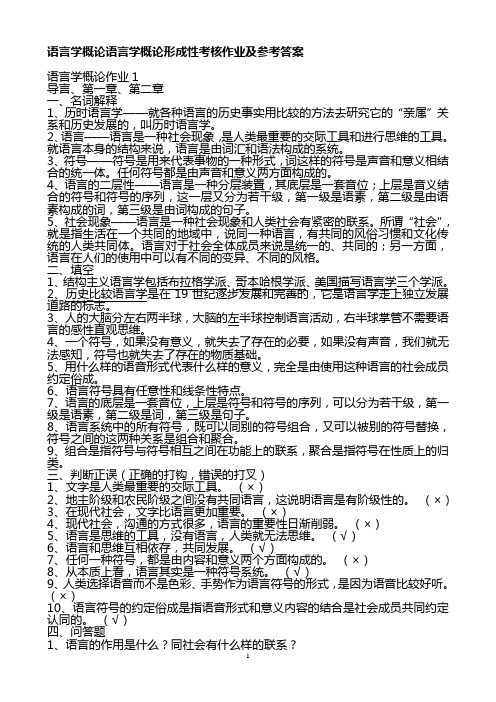
语言学概论语言学概论形成性考核作业及参考答案语言学概论作业1导言、第一章、第二章一、名词解释1、历时语言学——就各种语言的历史事实用比较的方法去研究它的‚亲属‛关系和历史发展的,叫历时语言学。
2、语言——语言是一种社会现象,是人类最重要的交际工具和进行思维的工具。
就语言本身的结构来说,语言是由词汇和语法构成的系统。
3、符号——符号是用来代表事物的一种形式,词这样的符号是声音和意义相结合的统一体。
任何符号都是由声音和意义两方面构成的。
4、语言的二层性——语言是一种分层装置,其底层是一套音位;上层是音义结合的符号和符号的序列,这一层又分为若干级,第一级是语素,第二级是由语素构成的词,第三级是由词构成的句子。
5、社会现象——语言是一种社会现象和人类社会有紧密的联系。
所谓‚社会‛,就是指生活在一个共同的地域中,说同一种语言,有共同的风俗习惯和文化传统的人类共同体。
语言对于社会全体成员来说是统一的、共同的;另一方面,语言在人们的使用中可以有不同的变异、不同的风格。
二、填空1、结构主义语言学包括布拉格学派、哥本哈根学派、美国描写语言学三个学派。
2、历史比较语言学是在19世纪逐步发展和完善的,它是语言学走上独立发展道路的标志。
3、人的大脑分左右两半球,大脑的左半球控制语言活动,右半球掌管不需要语言的感性直观思维。
4、一个符号,如果没有意义,就失去了存在的必要,如果没有声音,我们就无法感知,符号也就失去了存在的物质基础。
5、用什么样的语音形式代表什么样的意义,完全是由使用这种语言的社会成员约定俗成。
6、语言符号具有任意性和线条性特点。
7、语言的底层是一套音位,上层是符号和符号的序列,可以分为若干级,第一级是语素,第二级是词,第三级是句子。
8、语言系统中的所有符号,既可以同别的符号组合,又可以被别的符号替换,符号之间的这两种关系是组合和聚合。
9、组合是指符号与符号相互之间在功能上的联系,聚合是指符号在性质上的归类。
语言学概论作业答案(提交后显示答案)

语言学概论作业题找找59、60 题的答案,确定好后发我邮箱一下1、下列语言单位中,属于自由词组的是√此题回答正确1. A. 胸有成竹2. B. 智力投资2、下列特征中,普通话辅音音位/t/ 具有的区别特征是()。
√此题回答正确1. A. 塞3、随着语言的发展,印欧语系语言大多由“宾—动”型变成“动—宾”型,这是语法()√此题回答正确1. A. 词类的发展2. B. 组合规则的发展4、一般说来,新词、古词、方言词、行业词和外来词等√此题回答正确1. A. 属于一般词汇5、根据语言的形态分类,汉语属于()√此题回答正确1. A. 孤立语6、世界语(Esperanto)是()√此题回答正确√此题回答正确2. B. 德国人设计的3. C. 波兰人设计的7、以声音的高低来区别意义的语言单位叫√此题回答正确1. A. 时位2. B. 重位3. C. 调位8、英语 tooth → teeth 采用的语法手段是 ( )√此题回答正确1. A. 加词尾2. B. 变换重音的位置3. C. 词根内部音素的变化9、从造字方法看,兼用表意表音两种方法的文字叫() √此题回答正确1. A. 表意字2. B. 假借字3. C. 指事字4. D. 意音文10、现代汉语属于( )1. A. 法国人设计的1 . A. 历时语言学√此题回答正确4. D. 荀子11、成都话和上海话的差异,主要体现在( )√此题回答正确1. A. 语法2. B. 语音12、在汉词和英语的词汇中,借词占的比重( )√此题回答正确1. A. 汉语大于英语2. B. 英语大于汉语13、语言学的三大发源地是( ) √此题回答正确1. A. 中国、印度、埃及2. B. 中国、埃及、古罗马3. C. 中国、印度、古希腊和古罗马14、“名无固宜,约之以命,约定俗成谓之宜,异于约则谓之不宜 ”这句话是两千多年以前我国著名哲学家( )说的。
√此题回答正确1. A. 孔子2. B. 孟子3. C. 韩非子15、词是语言中()2. B. 共时语言学√此题回答正确1. A. 仿译词√此题回答正确1. A. 最小的单位2. B. 音义结合的最小单位3. C. 能够独立运用的最小单位16、一种语言中的词汇和语法,( )√此题回答正确1. A. 前者是有限的,后者是无限的2. B. 前者是无限的,后者是有限的3. C. 都是无限的4. D. 都是有限的17、现代汉语的 “着”、“了”、 “过”也表示(√此题回答正确1. A. 体18、法语、西班牙语、葡萄牙语的母语是(√此题回答正确1. A. 日耳曼语2. B. 拉丁语19、“拖拉机 ”一词是( ))的语法范畴4. D. 谱系分类B. 借词 3.C. 方言词 4.D. 意译词20、下列英语的读音中,包含有复辅音的是( )。
国开语言学概论大作业终考任务
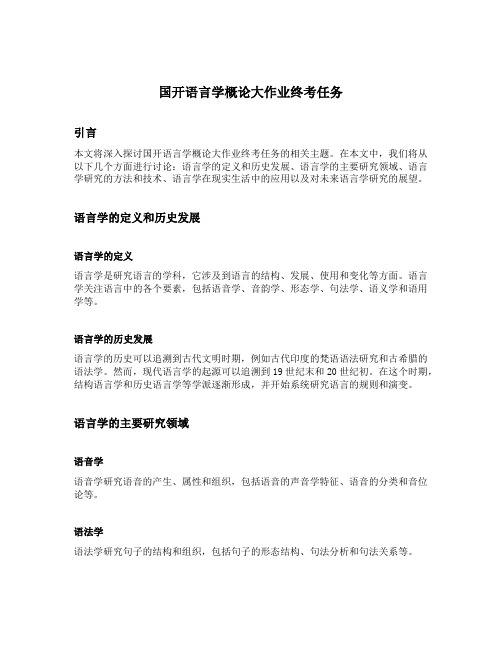
国开语言学概论大作业终考任务引言本文将深入探讨国开语言学概论大作业终考任务的相关主题。
在本文中,我们将从以下几个方面进行讨论:语言学的定义和历史发展、语言学的主要研究领域、语言学研究的方法和技术、语言学在现实生活中的应用以及对未来语言学研究的展望。
语言学的定义和历史发展语言学的定义语言学是研究语言的学科,它涉及到语言的结构、发展、使用和变化等方面。
语言学关注语言中的各个要素,包括语音学、音韵学、形态学、句法学、语义学和语用学等。
语言学的历史发展语言学的历史可以追溯到古代文明时期,例如古代印度的梵语语法研究和古希腊的语法学。
然而,现代语言学的起源可以追溯到19世纪末和20世纪初。
在这个时期,结构语言学和历史语言学等学派逐渐形成,并开始系统研究语言的规则和演变。
语言学的主要研究领域语音学语音学研究语音的产生、属性和组织,包括语音的声音学特征、语音的分类和音位论等。
语法学语法学研究句子的结构和组织,包括句子的形态结构、句法分析和句法关系等。
语义学语义学研究词汇和句子的意义,包括词汇的意义分类、语义关系和语义角色等。
语用学语用学研究语言在实际交流中的使用,包括语言交际、言语行为和语篇分析等。
语言学研究的方法和技术语料库语言学语料库语言学利用大规模的语料库数据进行语言学研究,通过分析实际语言使用的数据,研究语言的性质和规律。
实验语言学实验语言学通过设计和实施实验来研究语言现象,例如语音实验、语法实验和语义实验等。
认知语言学认知语言学研究语言的认知过程,探讨语言处理和理解的认知机制,包括语言意识、语法理解和语义加工等。
比较语言学比较语言学比较不同语言之间的差异和相似之处,研究语言的历史演化和分类关系。
语言学在现实生活中的应用教育与教学语言学研究对于语言教育和教学有着重要的指导作用,帮助人们更好地理解语言的规则和结构,掌握语言学习的方法和技巧。
翻译与传译语言学研究对于翻译与传译工作具有重要意义,帮助解决语言之间的转换和沟通问题,提高翻译和传译的质量和效率。
《语言学概论》作业
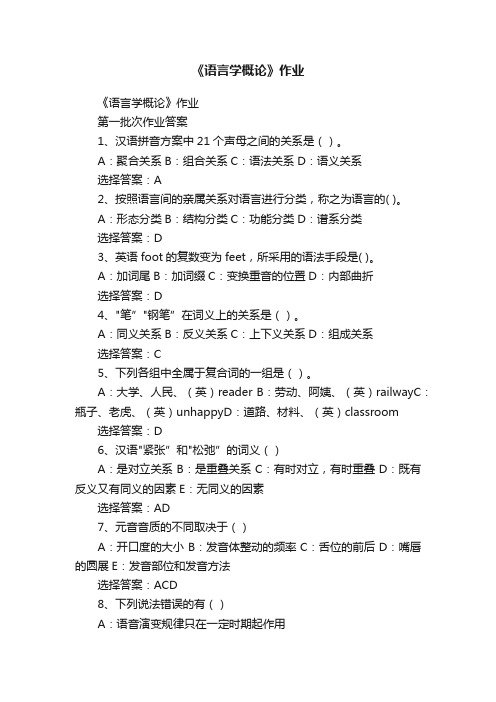
《语言学概论》作业《语言学概论》作业第一批次作业答案1、汉语拼音方案中21个声母之间的关系是()。
A:聚合关系B:组合关系C:语法关系D:语义关系选择答案:A2、按照语言间的亲属关系对语言进行分类,称之为语言的( )。
A:形态分类B:结构分类C:功能分类D:谱系分类选择答案:D3、英语foot的复数变为feet,所采用的语法手段是( )。
A:加词尾B:加词缀C:变换重音的位置D:内部曲折选择答案:D4、"笔”"钢笔”在词义上的关系是()。
A:同义关系B:反义关系C:上下义关系D:组成关系选择答案:C5、下列各组中全属于复合词的一组是()。
A:大学、人民、(英)reader B:劳动、阿姨、(英)railwayC:瓶子、老虎、(英)unhappyD:道路、材料、(英)classroom 选择答案:D6、汉语"紧张”和"松弛”的词义()A:是对立关系B:是重叠关系C:有时对立,有时重叠D:既有反义又有同义的因素E:无同义的因素选择答案:AD7、元音音质的不同取决于()A:开口度的大小B:发音体整动的频率C:舌位的前后D:嘴唇的圆展E:发音部位和发音方法选择答案:ACD8、下列说法错误的有()A:语音演变规律只在一定时期起作用B:语法发展中的类推作用是无限的,可推而广之,无一例外。
C:古代汉语中的浊塞音声母在现代汉语中已经消失了D:随着旧事物的消失,表示它们的词语也会随之消失E:词语的替换全部取决于语言系统内部的原因选择答案:BCE9、[a]、[A]、[?]是汉语普通话中同一音位的三个自由变体。
选择答案:错误10、汉字与汉语的音节是对应的,一个字记录一个音节,一个音节只用一个汉字记录。
选择答案:错误第二批次作业答案1.汉语中“北平→北京”、“德律风→电话”,产生词语替换的原因是(D )A:社会的因素B:语言系统内部的因素C:前者是语言系统内部因素,后者是社会因素D:前者是社会因素,后者是语言系统内部因素《庄子》里“匠石运斤成风”中的“匠石”,现代汉语说“名叫做石的工匠”。
语言学概论作业答案
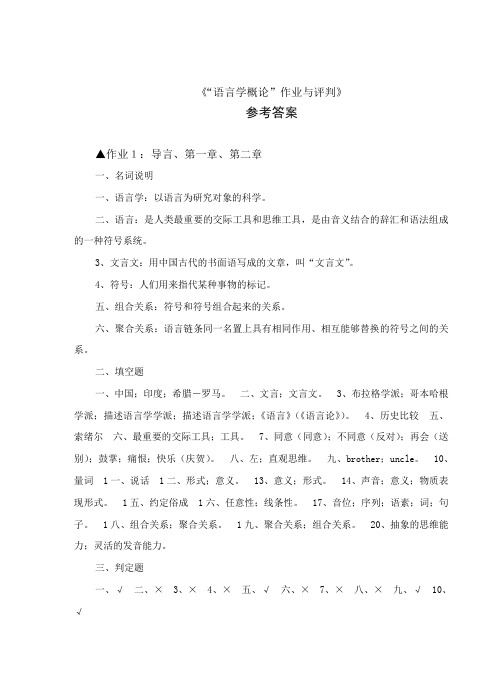
《“语言学概论”作业与评判》参考答案▲作业1:导言、第一章、第二章一、名词说明一、语言学:以语言为研究对象的科学。
二、语言:是人类最重要的交际工具和思维工具,是由音义结合的辞汇和语法组成的一种符号系统。
3、文言文:用中国古代的书面语写成的文章,叫“文言文”。
4、符号:人们用来指代某种事物的标记。
五、组合关系:符号和符号组合起来的关系。
六、聚合关系:语言链条同一名置上具有相同作用、相互能够替换的符号之间的关系。
二、填空题一、中国;印度;希腊-罗马。
二、文言;文言文。
3、布拉格学派;哥本哈根学派;描述语言学学派;描述语言学学派;《语言》(《语言论》)。
4、历史比较五、索绪尔六、最重要的交际工具;工具。
7、同意(同意);不同意(反对);再会(送别);鼓掌;痛恨;快乐(庆贺)。
八、左;直观思维。
九、brother;uncle。
10、量词1一、说话1二、形式;意义。
13、意义;形式。
14、声音;意义;物质表现形式。
1五、约定俗成1六、任意性;线条性。
17、音位;序列;语素;词;句子。
1八、组合关系;聚合关系。
1九、聚合关系;组合关系。
20、抽象的思维能力;灵活的发音能力。
三、判定题一、√二、×3、×4、×五、√六、×7、×八、×九、√10、√1一、√1二、×13、√14、√1五、×1六、√17、×1八、×1九、√20、√四、问答题一、历史比较语言学在语言学史上有何重腹地位?代表人物有哪些?19世纪一些语言学家运用历史比较法去研究语言,使语言学开始成立在科学的基础上,摆脱了过去的附庸地位,成为一门独立的科学,从而为现代语言学的成立打下了坚实的基础。
代表人物有丹麦的拉斯克,德国的博普、格林,俄国的沃斯托科夫等。
二、语言的作用是什么?举例说明。
语言是人类社会的交际工具。
每一个社会,不管它是经济发达的社会,仍是经济十分掉队的社会,都必需有属于自己的语言,都离不开语言那个交际工具,语言是组成社会必不可少的一个因素,是人类与动物相区别的重要特点之一。
《语言学概论》作业3

《语言学概论》作业3学号:班级:姓名:一、填空题。
1、根据使用情况,一般把语言系统中的词汇分为和两类。
2、基本词汇的主要特点有。
3、词义概括性的三个重要表现是。
4、多义词有多项意义,在最初的那项意义叫,离开上下文人们就能知道的那项意义叫。
汉语的“老”有“年纪大、经常、陈旧的”等意义,其中“年纪大”是,其余的是。
5、我国传统文字学中的“六书”是指。
6、指出下列汉字属于六书中的哪一种:手、泪、拖、刃,其(其中的“其”)是。
7、法语动词“是”的直陈式现在时有6种变化,比如“je(我) suis(是)”,“il(他)est(是)”,“nous(我们)sommes(是)”等,这反映了法语中谓词的语法范畴是。
8、根据语言的语法结构可以将世界上的语言分为四种类型。
9、词义派生的途径是引申,方式主要有和。
二、判断题。
1、如果一个词是多义词,那么它就有可能在不同的义项上与不同的词构成同义关系。
()2、相对于形态缺乏的语言而言,形态丰富的语言比较进步。
()3、非拼音文字记录意义,不记录语音。
()4、语言发展最基本的条件是语言内部各要素的影响。
()5、一个汉字代表一个音节,所以说汉字是音节文字。
()6、汉语里的一个字就是一个语素。
()7、由一个语素构成的词叫单纯词,单纯词都是单音节的。
()8、从意义和作用上看,词可以分为实词和虚词两大类。
()9、汉字具有超方言、超时空的特性。
()10、书面语的发展总是要先于口语的发展。
()。
语言学概论作业(3).

语言学概论作业(3)一、名词解释1、句子2、词组3、词4、语素5、词类6、形态7、语法意义8、语法形式9、语法手段10、语法范畴二、填空题1、是大家说话时必须遵守的习惯,不是语言学家规定的。
2、语法的和构成一种语言的语法规则。
3、语法单位主要有、、、。
4、句子按其语气可以分为陈述、疑问、祁使、感叹等不同的类型,例如“什么书他都喜欢看”是。
5、从意义和作用看,词可以分为和两大类。
6、语法研究通常以词为界,词以上的规则叫,词以下的规则叫。
7、根据在词中的不同作用,一般把语素分成、、和三类,例如“学习”中的两个语素是,“being”中的ing是,“reader”中的er 是。
8、的主要作用是改变一个词的形式,但不能构成新词。
9、一个词除去它的词尾,就是它的。
10、根据语素在词中的不同作用,把词根和词缀叫作语素,把词尾叫作语素。
11、汉语语素中,大部分是语素,不多,没有。
12、是由两个或两个以上构词语素组成的词。
13、由词根语素按一定的规则组合起来构成的词,称为。
由词根语素和词缀组合起来构成的词称为,其构词规则又叫作,或叫。
14、、、、、是语言里最基本的格式。
15、体现语法形式的语法手段主要有、、和。
16、直接组合起来构成一个更大的语法单位的两个组成成份叫作。
17、词形变化的多数形式是,也有一些使词根内部的元音和辅音。
18、几种句子格式表示相同或相近的结构意义,称为。
同一个句子表示集中不同的结构意义,称为。
19、从语法结构角度分类,一般把世界上的语言分为、、、四种类型,汉语属于。
20、孤立语的主要特点是缺乏,曲折语的主要特点是有丰富的。
三、单项选择题1、下列说法正确的是()。
A.语法的组合规则是潜在的B.语法的聚合规则是潜在的C.语法的组合规则存在于书面语言中D.语法的聚合规则存在于书面语言中2、下列说法正确的是()。
A.语法的组合规则是潜在的B.语法的聚合规则是潜在的C.语法的组合规则存在于书面语言中D.语法的聚合规则存在于书面语言中3、()在语言中处于枢纽地位,一般把它作为分析语法结构的最重要的语法单位。
国开语言学概论大作业终考任务

国开语言学概论大作业终考任务一、选题背景及意义语言学是研究语言的科学,其研究范围包括语音、语法、语义、语用等方面。
在当今社会中,随着全球化的发展和信息技术的普及,跨文化交流和语言学习已经成为越来越重要的话题。
因此,深入了解和掌握语言学知识对于我们提高跨文化交流能力和实现自身价值有着重要意义。
二、选题内容与研究方法本次国开语言学概论大作业终考任务,我选择了“汉字与拼音的对比研究”这一主题。
本文将从以下几个方面进行探讨:1. 汉字与拼音的历史渊源及发展变迁2. 汉字与拼音在教育中的应用情况分析3. 汉字与拼音在实际生活中的使用对比研究4. 汉字与拼音对于跨文化交流的影响分析本文采用文献资料法和实证调查法相结合的方法进行研究。
首先,通过查阅相关资料了解汉字和拼音的历史渊源及发展变迁。
其次,通过对教育领域的调查研究,分析汉字和拼音在教育中的应用情况。
然后,通过实地观察和问卷调查等方式,对汉字和拼音在实际生活中的使用进行对比研究。
最后,结合前面的研究结果,分析汉字和拼音对于跨文化交流的影响。
三、研究结果与讨论1. 汉字与拼音的历史渊源及发展变迁汉字是中国古代文化遗产之一,其历史可以追溯到公元前14世纪左右。
汉字是表意文字,每个字都有自己独特的含义和构造。
而拼音则是一种注音文字系统,它使用拉丁字母来表示中文发音。
拼音最早出现于19世纪末期,在20世纪50年代被正式推广使用。
2. 汉字与拼音在教育中的应用情况分析在中国大陆地区的教育领域中,汉字是学生必须学习掌握的基本技能之一。
而拼音则通常作为学习汉语语言能力考试(HSK)的一部分。
在幼儿教育领域中,拼音往往被用来帮助幼儿学习汉字。
3. 汉字与拼音在实际生活中的使用对比研究在日常生活中,汉字和拼音都有着广泛的应用。
例如,在地铁站、公交车站等公共场所,通常会同时标注汉字和拼音,以方便外国游客或不懂中文的人士使用。
此外,在电视、广播等媒体上也经常出现汉字和拼音并存的情况。
语言学概论 作业
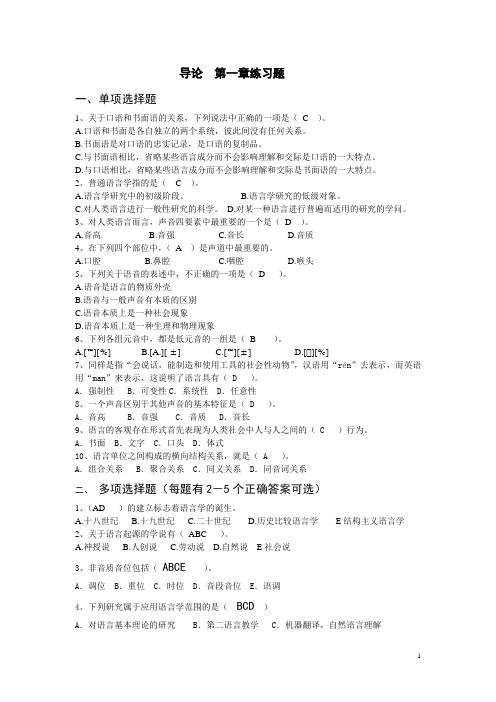
导论第一章练习题一、单项选择题1、关于口语和书面语的关系,下列说法中正确的一项是(C )。
A.口语和书面是各自独立的两个系统,彼此间没有任何关系。
B.书面语是对口语的忠实记录,是口语的复制品。
C.与书面语相比,省略某些语言成分而不会影响理解和交际是口语的一大特点。
D.与口语相比,省略某些语言成分而不会影响理解和交际是书面语的一大特点。
2、普通语言学指的是( C )。
A.语言学研究中的初级阶段。
B.语言学研究的低级对象。
C.对人类语言进行一般性研究的科学。
D.对某一种语言进行普遍而适用的研究的学问。
3、对人类语言而言,声音四要素中最重要的一个是(D )。
A.音高B.音强C.音长D.音质4、在下列四个部位中,(A )是声道中最重要的。
A.口腔B.鼻腔C.咽腔D.喉头5、下列关于语音的表述中,不正确的一项是(D )。
A.语音是语言的物质外壳B.语音与一般声音有本质的区别C.语音本质上是一种社会现象D.语音本质上是一种生理和物理现象6、下列各组元音中,都是低元音的一组是(B )。
A.[ ][ ]B.[A.][ ]C.[ ][ ]D.[ ][ ]7、同样是指“会说话,能制造和使用工具的社会性动物”,汉语用“rén”去表示,而英语用“man”来表示,这说明了语言具有( D )。
A.强制性 B.可变性C.系统性 D.任意性8、一个声音区别于其他声音的基本特征是( D )。
A.音高 B.音强 C.音质 D.音长9、语言的客观存在形式首先表现为人类社会中人与人之间的( C )行为。
A.书面 B.文字 C.口头 D.体式10、语言单位之间构成的横向结构关系,就是( A )。
A.组合关系 B.聚合关系 C.同义关系 D.同音词关系二、多项选择题(每题有2-5个正确答案可选)1、(AD )的建立标志着语言学的诞生。
A.十八世纪B.十九世纪C.二十世纪D.历史比较语言学E结构主义语言学2、关于语言起源的学说有(ABC )。
(0126)《语言学概论》西南大学1906批次大作业答案
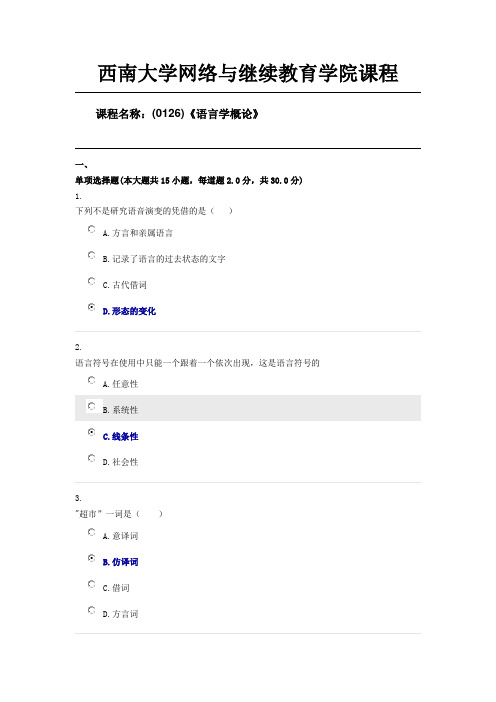
西南大学网络与继续教育学院课程
一、
单项选择题(本大题共15小题,每道题2.0分,共30.0分)
1.
下列不是研究语音演变的凭借的是()
A.方言和亲属语言
B.记录了语言的过去状态的文字
C.古代借词
D.形态的变化
2.
语言符号在使用中只能一个跟着一个依次出现,这是语言符号的
A.任意性
B.系统性
C.线条性
D.社会性
3.
"超市”一词是()
A.意译词
B.仿译词
C.借词
D.方言词
4.
“小偷”一词往往使人厌恶,这是词语的()
A.理性意义
B.感情色彩
C.语体色彩
D.象征功能
5.
下列属于音位文字的是()
A.古埃及文
B.阿拉伯文
C.英文
D.汉字
6.
失语症患者
A.不能正常思维
B.仅具有抽象思维能力
C.思维能力不一定受到影响
D.大脑右半球语言中枢受到损伤
7.
下列关于语言和说话,表述正确的是
A.语言就是我们每天说的话
B.语言就是我们说的每一个句子
C.语言是用有限的材料和有限的规则组成的系统
D.语言等同于说话。
语言学指导书作业(新版)

语言学指导书作业导言一、填空1、语言学的三大发源地是____________、_____________和____________。
2、语言学是_______世纪成为独立的学科的,其标志是________________。
3、现代语言学的标志性著作是瑞士语言学家___________的____________。
4、语言交际过程可分为__________—_________—__________—_________—_________五个阶段。
5、印度最早的经典所使用的语言是__________。
6、________、_________、__________是中国“小学”的主要研究内容。
二、判断正误1、语文学主要是研究古代的口语和书面语。
()2、语言有自身结构的独立性,与系统之外的社会环境没有关系。
()3、理论语言学是研究语言一般规律的,不受具体语言研究影响。
()4、语言形式和内容的关系是语言研究的根本问题。
()三、思考题1、语言与人类社会生活有哪些密切关联?2、语文学研究有哪些特征?3、语言学学科内部都有哪些研究分类?如何看待它们之间的关系?4、为什么说语言学是一门基础科学?5、为什么说语言学是自然科学和人文科学的桥梁?6、如何看待语言学研究的意义和价值?第一章一、填空1、语言的功能包括___________功能和__________功能。
2、语言的社会功能包括__________功能和__________功能。
3、在各种信息传递形式中,___________是第一性的、最基本的手段。
4、人的大脑分左右两个半球,语言功能及计数、推理能力等由_________半球掌管,音乐感知、立体图形识别等能力由__________半球制约。
5、儿童语言习得一般经过_________阶段和________阶段,这是儿童学话的关键两步。
二、判断正误1、文字是建立在语言基础之上的再编码形式。
()2、当说话者陈述一个客观事实时,话语中不具有主观性。
- 1、下载文档前请自行甄别文档内容的完整性,平台不提供额外的编辑、内容补充、找答案等附加服务。
- 2、"仅部分预览"的文档,不可在线预览部分如存在完整性等问题,可反馈申请退款(可完整预览的文档不适用该条件!)。
- 3、如文档侵犯您的权益,请联系客服反馈,我们会尽快为您处理(人工客服工作时间:9:00-18:30)。
The Understanding of MorphologyAfter learning Chapter3 Morphology, I get more than I had imagined, knowing something new. For example, I can define the free and bound morphemes and distinguish the differences of foresaid terms and dissect the words into morphemes and root. There are some understandings of it below.A sentence is not the smallest grammatical unit, as it consists of other smaller units called words. In many languages, what appear to be single forms actually turn out to contain a large number of ―word-like‖ elements. For example, in English, the word unfriendly is formed from friend, the adjective forming suffix –ly and the negative prefix un-. These three ―word-like‖ el ements are the most basic elements of meaning.Firstly, morphology, in my opinion, refers to the study of the internal structure of words and the rules by which words are formed. We can divided all words into two main groups, one group is open class words that also are called content words, which includes nouns, verbs, adjectives and adverbs; the other group is close class words that are also called grammatical/functional words, which includes conjunction, prepositions, articles, pronouns and determiners.Secondly, morphemes—the minimal unit of meaning, is the smallest unit that carries grammatical and /or semantic meaning. For example, the English word tourists contain three morphemes: tour------the root, -ist ------person who does something, -s ------indicating plurality. Morphemes also can be divided into two main groups that are free morphemes and bound morphemes; what’s more, each of them also contains two groups. Next, I will explain them one by one. Free morpheme can stand alone as words. They can be used on their own, such car, tree, sing, dance, etc. A word must contain an element that can stand by itself. Such an element is called a root. A word may contain more than one root, in which case it is a compound word, e.g. bookshop and blackbird. In this part, we should understand the different between root and stem.A root is that part of the word left when all the affixes (inflectional & derivational) are removed, e.g. ―desire‖ in ―desirable‖, ―care‖ in ―carefully‖, while a stem is part of a word-form which remains when all inflectional affixes have been removed, e.g. ―undesirable‖ in ―undesirables‖. A stem of a word may be contains several kinds below. (i)A simple stem consisting of only one morpheme, in which case the root and the stem are the same, e.g. work is both the stem and the root. (ii) A root plus a derivational affix, e.g. worker, work is the root, worker is the stem. (iii) Two or more roots, e.g. workshop, both work and shop are roots, workshop is the stem.Thirdly, I will explain the affix. There are three kinds of it: prefixes, suffixes and infixes. Prefixes are the morphemes that can be joined to the beginning of the root or stem. Prefix can change the meaning or function of the word, e.g. un-, dis-, anti-, ir-, etc. Suffixes are the morphemes that can be joined to the end of the root or stem. Suffix can also change the meaning or function of the word, e.g. -ful, -er, -ish, -ness, -able, -tive, -tion, etc. Infixes are the morphemes that are inserted into other morpheme. Compared to prefixes and suffixes, infixes are relatively rare in the languages of the world.Fourthly, I will introduce free morphemes and bond morphemes in details. Freemorphemes contain lexical morpheme and functional morpheme. Lexical morpheme carries the content of massages we convey, e.g. book, desk and house. Functional morpheme consists of the functional words in language. Bound morpheme is one that may appear with at least one other morpheme. They cannot normally stands alone but function only as parts of words, such as ―-s‖ ―-er‖―-ed‖ and ―-ing‖etc. Bound morphemes also contain two categories that are derivational morphemes and inflectional morphemes. Derivational morphemes are used to make new words and to make words of a different grammatical category from the stem. Inflectional morphemes are not used to produce, but rather to show aspects of the grammatical function of a word. They are used to indicate whether a word is singular or plural, whether it is in the past tense or present tense, and whether it is a possessive or comparative form. English has only eight inflectional morphemes: noun + -’s,-s; verb + -s,-ing,-ed,-en; adjective + -er,-est.Finally, I will say something about the difference between derivational and inflectional morphemes. One is that derivational morpheme can change the grammatical category of word while inflectional morpheme never alters the grammatical category of word. The other is that derivational morpheme can create an entirely new word, but inflectional morpheme only creates a different version of the adjective.。
